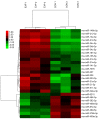Analysis of altered microRNA expression profiles in the kidney tissues of ethylene glycol-induced hyperoxaluric rats
- PMID: 27748900
- PMCID: PMC5102036
- DOI: 10.3892/mmr.2016.5833
Analysis of altered microRNA expression profiles in the kidney tissues of ethylene glycol-induced hyperoxaluric rats
Abstract
Calcium oxalate stones account for >80% of urinary stones, however the mechanisms underlying their formation remains to be elucidated. Hyperoxaluria serves an important role in the pathophysiological process of stone formation. In the present study, differences in the miRNA expression profiles between experimental hyperoxaluric rats and normal rats were analyzed, in order to identify target genes and signaling pathways involved in the pathogenesis of hyperoxaluria. Ethylene glycol and ammonium chloride was fed to male hyperoxaluric rats (EXP) and normal age‑matched male rats (CON). The oxalate concentration in the urine of each experimental rat was collected every 24 h and measured on day 14. Three rats exhibiting the highest concentrations were selected for microarray analysis. Microarray analysis was performed to evaluate differences in the expression of microRNA (miRNA) in the kidney tissues from EXP and CON groups, and miRNAs that exhibited a >2‑fold or a <0.5‑fold alteration in expression between these groups were screened for differential expression patterns according to the threshold P‑values. Reverse transcription‑quantitative polymerase chain reaction analysis was employed to confirm the microarray results. In order to predict the potential role of miRNAs in pathophysiological processes, gene ontology (GO), pathway and target prediction analyses were conducted. A total of 28 miRNAs were observed to be differentially expressed (>2‑fold change) between EXP and CON groups. Among these miRNAs, 20 were upregulated and 8 were downregulated. GO and pathway analyses revealed that the insulin resistance and phosphatidylinositol‑bisphosphonate 3‑kinase/AKT serine threonine kinase signaling pathways were potentially associated with miRNA regulation in this setting. In conclusion, the results of the present study identified differentially expressed miRNAs in hyperoxaluric rats, and provided a novel perspective for the role of miRNAs in the formation of calcium oxalate stones.
Figures






Similar articles
-
Differential microRNA expression profiles and bioinformatics analysis between young and aging spontaneously hypertensive rats.Int J Mol Med. 2018 Mar;41(3):1584-1594. doi: 10.3892/ijmm.2018.3370. Epub 2018 Jan 9. Int J Mol Med. 2018. PMID: 29328372 Free PMC article.
-
Oral administration of oxalate-enriched spinach extract as an improved methodology for the induction of dietary hyperoxaluric nephrocalcinosis in experimental rats.Toxicol Mech Methods. 2018 Mar;28(3):195-204. doi: 10.1080/15376516.2017.1388459. Epub 2017 Oct 24. Toxicol Mech Methods. 2018. PMID: 28980857
-
Bioinformatic analysis of microRNA-mRNA expression profiles of bladder tissue induced by bladder outlet obstruction in a rat model.Mol Med Rep. 2017 Oct;16(4):4803-4810. doi: 10.3892/mmr.2017.7188. Epub 2017 Aug 7. Mol Med Rep. 2017. PMID: 28791388
-
The hyperoxaluric syndromes.Endocrinol Metab Clin North Am. 1990 Dec;19(4):851-67. Endocrinol Metab Clin North Am. 1990. PMID: 2081515 Review.
-
Nephrolithiasis: a consequence of renal epithelial cell exposure to oxalate and calcium oxalate crystals.Mol Urol. 2000 Winter;4(4):305-12. Mol Urol. 2000. PMID: 11156696 Review.
Cited by
-
Alteration of exosomes secreted from renal tubular epithelial cells exposed to high-concentration oxalate.Oncotarget. 2017 Oct 4;8(54):92635-92642. doi: 10.18632/oncotarget.21517. eCollection 2017 Nov 3. Oncotarget. 2017. PMID: 29190944 Free PMC article.
-
Analyses of long non-coding RNA and mRNA profiling using RNA sequencing in calcium oxalate monohydrate-stimulated renal tubular epithelial cells.Urolithiasis. 2019 Jun;47(3):225-234. doi: 10.1007/s00240-018-1065-7. Epub 2018 Jun 15. Urolithiasis. 2019. PMID: 29947995
-
Non-Coding RNAs in Kidney Stones.Biomolecules. 2024 Feb 11;14(2):213. doi: 10.3390/biom14020213. Biomolecules. 2024. PMID: 38397450 Free PMC article. Review.
-
Dietary vinegar prevents kidney stone recurrence via epigenetic regulations.EBioMedicine. 2019 Jul;45:231-250. doi: 10.1016/j.ebiom.2019.06.004. Epub 2019 Jun 13. EBioMedicine. 2019. PMID: 31202812 Free PMC article.
-
miR-103a-3p Silencing Ameliorates Calcium Oxalate Deposition in Rat Kidney by Activating the UMOD/TRPV5 Axis.Dis Markers. 2022 Feb 23;2022:2602717. doi: 10.1155/2022/2602717. eCollection 2022. Dis Markers. 2022. PMID: 35251369 Free PMC article.
References
MeSH terms
Substances
LinkOut - more resources
Full Text Sources
Other Literature Sources

